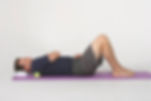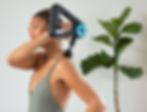How You Can Use Self-Myofascial Release (SMR) To Decrease Pain and Increase Performance
- Stephen Strumos
- Jan 24, 2020
- 4 min read
Updated: Apr 6, 2020
Self-myofascial release is a technique that inhibits overactive muscle fibers. People usually refer to it as foam rolling but there are many tools and tricks you can use to the same effect.
SMR’s main goal is to correct muscle imbalances and release knots and tight points in the muscle. These naturally occur as we move on a daily basis but staying in certain positions for long periods of time (i.e. sitting) or lifting with improper form can exacerbate imbalances.
On one side of an imbalance, there’s a tight muscle or group of muscles. Stretching alone doesn’t solve the issue because the muscle is in a resistant state. In order to make it more accessible to stretch, we first need to inhibit overactive muscle.
The exact mechanism in which it works isn’t entirely clear. But it’s believed to work by stimulating receptors through sustained pressure on trigger points in order to decrease activity in the area. (1) Then this allows for the application of stretching and strengthening work to more effectively correct imbalances.
There are a variety of tools you can use to apply SMR. They vary based on ease of use, cost, and ability to reach deeper areas of tissue.
If you’re doing this for the first time you should know that rolling is initially very uncomfortable. Once you find trigger points it will be painful. But the more you do it the more you will get used to it.
This is why you should start with softer rollers that hit only superficial layers of tissue. This will help you ease into SMR. Over time you can work your way into a harder, more rigid material.
Depending on which tool you use, there are plenty of options and similar progressions you can follow:
Rollers:

Start with soft and work towards harder ones as mentioned before. The diameter of the roller also makes a difference as smaller diameter rollers penetrate into deeper tissue.
Balls:

Similar to rollers, start with softer, larger diameter balls (medicine balls or softballs) and work towards harder and smaller ones (golf balls or lacrosse balls).
Handheld rollers:

These tools are best for those who are unable to get on to and up from the ground comfortably. They allow you to control how much force you apply to your tissues.
Assisted devices:

These are best to hit hard to reach areas not accessible by other means. Like the handheld roller, you control how much force to apply.
Vibration devices:

While a bit more costly and often requiring a second person to help, these tools can reach very deep areas of tissue. They not only hit trigger points but create a vibration wave around the surrounding area to help mobilize the tissue.
Key points to remember when applying SMR:
1. Make sure you maintain proper alignment while rolling. (Keep your spine neutral and avoid bad postures like a hunchback and a forward head)
2. Keep your body relaxed when applying pressure to ensure that you’re hitting the deepest area of tissue.
3. You can use your arms and legs to alter the amount of pressure you’re applying to the trigger point.
4. Roll SLOWLY. You’re trying to decrease the activation of your tissues.
5. Pause on painful areas (trigger points and knots) until you feel a release of tension or a softening of the tissue. This can take between 30-90 seconds.
6. The more restriction and tension there is in a tissue, the more uncomfortable it will be to mobilize. As you consistently apply SMR, the treatment will become less painful.
7. There are no known reasons why SMR can’t be done on a daily basis. Spending 5-10 minutes every day is a great way to take care of your body. (I personally find doing it before bed helps me wake up feeling looser)
I have clients that used to depend on massages and chiropractic treatments just to get through an average day. No offense to those professions, but buying a $4 lacrosse ball has done wonders for myself and many of my clients. I have people that swear by it as their personal massage tool.
While SMR is amazing to do for nearly every single person. There are 2 areas I want to caution you from rolling. Your lower back and your neck.
Anchoring a roller on your lower back with gravity pushing down can actually make lower back pain worse. The lumbar spine is naturally in extension and has no support from the shoulder blades and ribcage like your upper spine does.

Your neck is affected in a similar way. Lying completely on your cervical spine when it has no support is asking for trouble. There are certain tools that are more precise that you can use to target the head and neck that don’t put stress on your spine. A foam roller isn’t one of them.
Remember also that our target here is muscle. We never want to roll on bone, particularly your spine. If you ever experience numbing or tingling feelings then back off. You most likely found a nerve or blood vessel.
With that in mind, SMR treatments are amazing for decreasing pain caused by muscle imbalances and increasing performance. Once you free up inhibited muscle and bring your body back into balance, you’ll be able to activate your muscles more efficiently and your risk for having bad posture decreases. It’s a fantastic tool for rehabbing an injury as part of a corrective program and is incredibly easy to perform.
There’s no reason not to jump on the bandwagon.
To your good health,

References:
Hou C-R., Tsai, L-C., Cheng, K-F., Chung K-C., Hong C-Z. (2002.) Immediate effects of various therapeutic modalities on cervical myofascial pain and trigger point sensitivity. Arch Phys Med Rehabil. 83:1406-1414.
Getting started can be a tough thing to do, and the main reason is that people don’t know where to start.
That’s where I come in.
Regardless of whether you live in the GTA and can do in-person coaching with me or you live anywhere else in the world and can do online coaching, I can put a plan in place to help you get to where you need to be.
For more information, check out my coaching options or what my clients have to say.
.png)